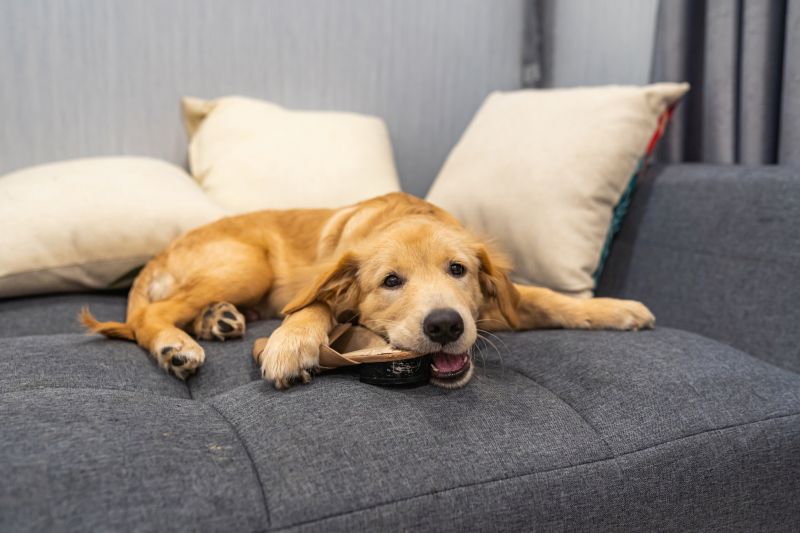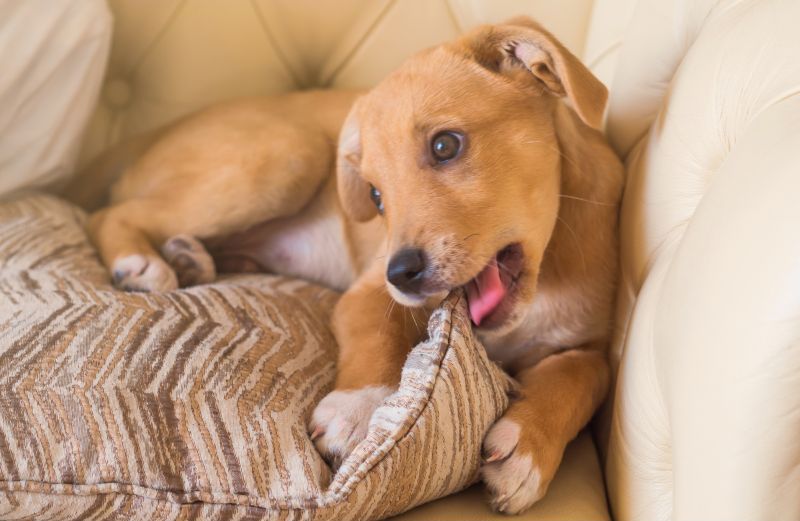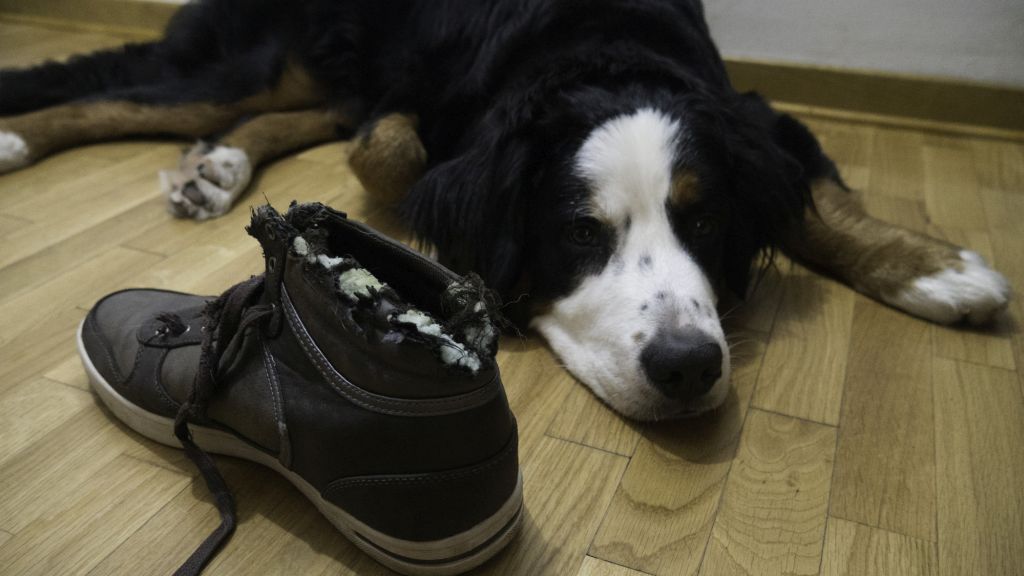Chewing is one of the most annoying and problematic dog behaviors out there. Some dogs can be so destructive that they send you into fits of anger and depression as you try to figure out why they keep doing this. If you are at your wit’s end with a chewing problem, we are here to help. Here are some useful tips that will tell you how to stop a dog from chewing.
Why Is My Dog Chewing Everything?
As with any problem, you have to understand it before you can find a solution. You certainly can’t just ask the dog why he tore your home to pieces, so a little bit of detective work is necessary.
The Bored Dog
The simplest explanation for your dog’s excessive chewing is that they are bored. Sure, they may not have the same level of intelligence that we do, but dogs are among the world’s most intelligent animals. Their many centuries of interacting with humans have only helped them become smarter, and an intelligent mind needs stimulation. Otherwise, they will have a tendency to get into trouble.

There are a lot of things that you can do to help your dog alleviate their boredom. Chew toys are an obvious step in the right direction, but their effectiveness is limited. Many compulsive chewers will avoid the toys that you buy for them and destroy your stuff instead.
The company of another dog tends to be a much more effective step. In the wild, canines get most of their entertainment and stimulation from interacting with the rest of the pack. Even when those interactions are negative, they still keep the dog’s life interesting. As a human, you cannot fully simulate that dynamic in the way that another dog would do. To maximize the effectiveness of this method, you should expose them to a well-behaved dog. Otherwise, their destructive behaviors could end up being reinforced rather than defeated.
Separation Anxiety
Separation anxiety and boredom often go together, at least when it comes to dogs. Being pack animals, they don’t generally like to be alone. Even after centuries of domestication, this wild tendency to “pack up” is still with them. If you try to work against that instinct, you are fighting against nature itself (which often doesn’t work out so well).
Separation anxiety is a well-documented problem in dogs, but it is important to remember that you cannot read a dog’s mind. Some people have a tendency to ascribe all destructive chewing to “separation anxiety.” The people who do this will generally have no idea of what the words even mean. If you have a dog that is perfectly well-behaved until they are left alone, separation anxiety is one likely cause.
Fabric Sucking Tendency
Have you ever wondered why chewers tend to go after cloth so much? Things like blankets, clothes, and pillows tend to be some of the most frequent chewing targets. Sometimes, they will even pull up a section of your carpet and suck on it for a while. The sucking is often followed by chewing (probably because it’s already in their mouth anyway).

In most cases, this is caused by early weaning. Although the mother’s milk is primarily there to provide nourishment, the nursing process is also an important bonding and comforting experience. Pups who are pulled from the teat too early will always be looking for the reassurance that they didn’t really get from mom. At times, they will even suck on themselves out of desperation!
This is why you should always allow nature to take its course when a female has pups. Remember that dogs have been rearing their young without human help since the beginning of time, and their instincts are programmed in that direction. We should, of course, help them in any way we can, but mother usually knows best.
Your Dog Is Hungry
This is a simple explanation that many of us might overlook. When food is scarce, chewing serves to help the dog cope with their hunger. On a mental level, it serves as a partial substitute for a good meal. If your dog is constantly begging for food and hovering around the area where the food is stored, it can be an indicator that they are simply not eating enough.
Like humans, dogs have varying metabolic systems (process energy at different rates), which is why some of them tend to be fatter or skinnier than others. Thus, not every dog needs to be given the same amount per day. Of course, it can be hard to tell because a dog will usually take food when it is offered. Also, even if your dog is eating enough, their food might not be nutrient-rich enough to provide them with proper nourishment.
Puppy Teething
Everyone knows that puppies chew more often than adult dogs, and that is usually due to teething. Of course, puppies are not babies, and so teething works a little differently for them. Human babies are born without teeth, and their baby teeth grow in once nursing has been completed. This obviously makes things easier for the mother, so it’s a good thing. Pups, on the other hand, have their baby teeth within two weeks of birth. Within six months, those baby teeth will fall out and be replaced with the teeth that your dog will have for the rest of its life.
While this process is going on, there will be some soreness and pain in the gums, and dogs will often chew on things to help relieve that pain. This is good for the dog in the long run because it will strengthen and toughen their teeth and gums. In the short term, though, you will need to keep them away from anything that you value highly.
Tips To Stop Your Dog From Chewing Things

Now we come to the important part of the article. Hopefully, you now understand a little bit more about why dogs chew, but that isn’t really all that practical. In this section, we will talk about how to stop a dog from chewing. All of these steps can be employed separately or combined into a holistic approach.
Dog-Proof Your Home
You may not be able to control your dog at all times, but you can control your environment. If you are dealing with a chewing problem, then you probably know what kinds of items your animal is more likely to target. Some go for clothes and blankets while others are more fond of plastic bottles from the trash, while some others might even go after electrical cords.
Depending on the extremity of your problem, you might need to go to serious trouble to dog-proof your home. You can enclose electrical cords in a metal pipe (PVC can be destroyed by most dogs) and get a metal trash can with a lid (harder to access). You should also remember that they most often target objects that are lying on the floor or stored at floor level. Thus, anything that you value highly should be placed on a high shelf or otherwise put out of the dog’s reach.
We can’t tell you exactly how you should dog-proof your home because every home (and every dog) is a little different. As a general rule, however, you just need to make sure the dog has little to no access to their favorite chewing targets. For smaller dogs, thick plastic totes are often sufficient to protect your valuables. If you have a lot of dogs in the house, you should probably go ahead and switch all your carpet for hard flooring as well. This part actually isn’t so bad because hard floors are easier to clean and maintain anyway.
Provide Plenty Of Chew Toys
This solution is basically a diversion. By giving the dog something appropriate, you can reduce the chances that they will chew on something inappropriate. However, it isn’t as simple as buying a toy and throwing it to them. If you just give them the toy with no fanfare or interaction, they may be confused as to what they are supposed to do.
When you give your dog a new toy of any kind, you should introduce it to them as if it were a treat. You might even want to use the word “treat” when you are introducing the toy. If they have learned to recognize this word, they will see the ball as their property, which is correct.
At the same time, you have to interrupt them by scolding them when they chew anything else. It will take some trial and error, but they will eventually learn that they can make their lives easier by chewing only designated toys.
Use Edible Chew Treats
Treats are an important part of any dog’s training. Where disciplinary action provides negative reinforcement, treats are the easiest and simplest way to provide positive reinforcement. Both are necessary for the training of a good dog, obviously. However, we are specifically concerned with the chewing problem here, and that’s why it can be good to give your dog some chew treats.

A good example of a chew treat would be a pig’s ear. These are commonly sold at pet stores and given to dogs and are (of course) totally edible. In essence, this is just a piece of pork jerky. While an edible treat will only provide a few moments of enjoyment, a chew treat can provide hours. More importantly, those hours spent chewing on a treat will be hours that aren’t spent destroying your home!
Close Supervision
If you are dealing with a really extreme case, you may need to use a rather extreme solution. We aren’t talking about extreme discipline here, but extreme vigilance. Dogs (especially pups) tend to do their worst mischief when they are left alone, so you can simply ensure that they are never left unsupervised. Eventually, they will learn what is expected of them and will fall into desirable habits.
One way to do this is to use the old crate training method. Basically, you put them in a cage and only bring them out when they can be supervised. Now, we want to emphasize that you should never leave them in that cage for more than a few hours, especially if we are talking about a small cage here.
Leaving a dog in a small cage for hours is cruel and unnecessary. If there are multiple people in your household, everyone should take turns supervising the dog. By applying near-constant supervision, you can effectively force the dog to develop good behavioral tendencies.
Give Them Plenty Of Exercise
As we detailed above, canine chewing is often the result of simple boredom. When humans are bored, we tend to do things with our hands. When dogs are bored, they tend to do things with their teeth. Thus, you need to help them relieve some of that pent-up energy.
Regular walks are a good place to start, and some dogs enjoy wrestling and roughhousing with their owners (bulldog breeds particularly love this kind of rough play). If you want to go to an extreme, you could even build an obstacle course through which your dog can run. Show dogs often run these courses as a contest, and they provide both physical and mental stimulation.
Teach Them A Specific Command
Dogs may not understand human language, but they can definitely understand individual words and short phrases. As such, you should teach your dog a simple command that tells them when to stop chewing. “Leave it” is probably the most common, but you can use whatever word or phrase you like.
Numb Your Dog’s Teething Pain
As we talked about before, teething is one of the main reasons that puppies tear up your stuff. They are mainly doing this to cope with the pain and soreness in their gums, but you can give them a better way to deal with the problem. The key to this is to use the cold. Numb gums feel kind of weird, but they don’t really feel pain, either. Try giving your pup a wetted and frozen washcloth or maybe just some ice cubes.
Restricting Access

One little thing to remember is this: They can’t chew something that is out of reach. Instead of trusting that they will leave your most prized possessions alone, you should instead assume that they will be targeted. As such, there needs to be at least one area in your home that is a no-go zone for dogs. This is where you can store anything that needs to be kept out of their reach. You can use baby gates, but those won’t be good enough for large dogs. A locked door is far more sure.
Consider A Spray Deterrent
They make all kinds of spray deterrents that help to keep dogs from chewing on things. The most popular ones are made from the concentrated essence of sour apples, so they taste terrible. You can test it on yourself by putting one drop in a glass of water. The result is highly unpleasant and would probably be just as unpleasant for your dog. Still, it’s not going to do any harm unless your dog is allergic to apples.
Teach The Dog To “Trade”
Some people will teach their dog to “trade” non-chewable objects for chewable ones. For instance, if you see your dog chewing on the edge of a blanket, you can offer them a rawhide chew treat. When they take that treat, you take the blanket, thus showing the dog that it belongs to you. Not everyone likes this method, but it is another tool to put in the box.
Don’t Use A Fear-Based Approach
Don’t chase your dog, beat them, or do anything like that. It is tempting to let your anger take over, but the dog will most likely learn nothing. If anything, they will just learn to be fearful of their owner, and that isn’t productive in any way. Obviously, you do have to apply discipline when they misbehave, but you should always apply it gently.
Conclusion
We know that a chewing dog can be an intensely frustrating thing, especially when they destroy things that are particularly valuable to you. However, any problem can be solved with a clear head and a rational mind, and this is no exception. We hope that we have answered your questions and given you plenty of good ideas as you battle this problem. If so, please feel free to comment and share this work.
